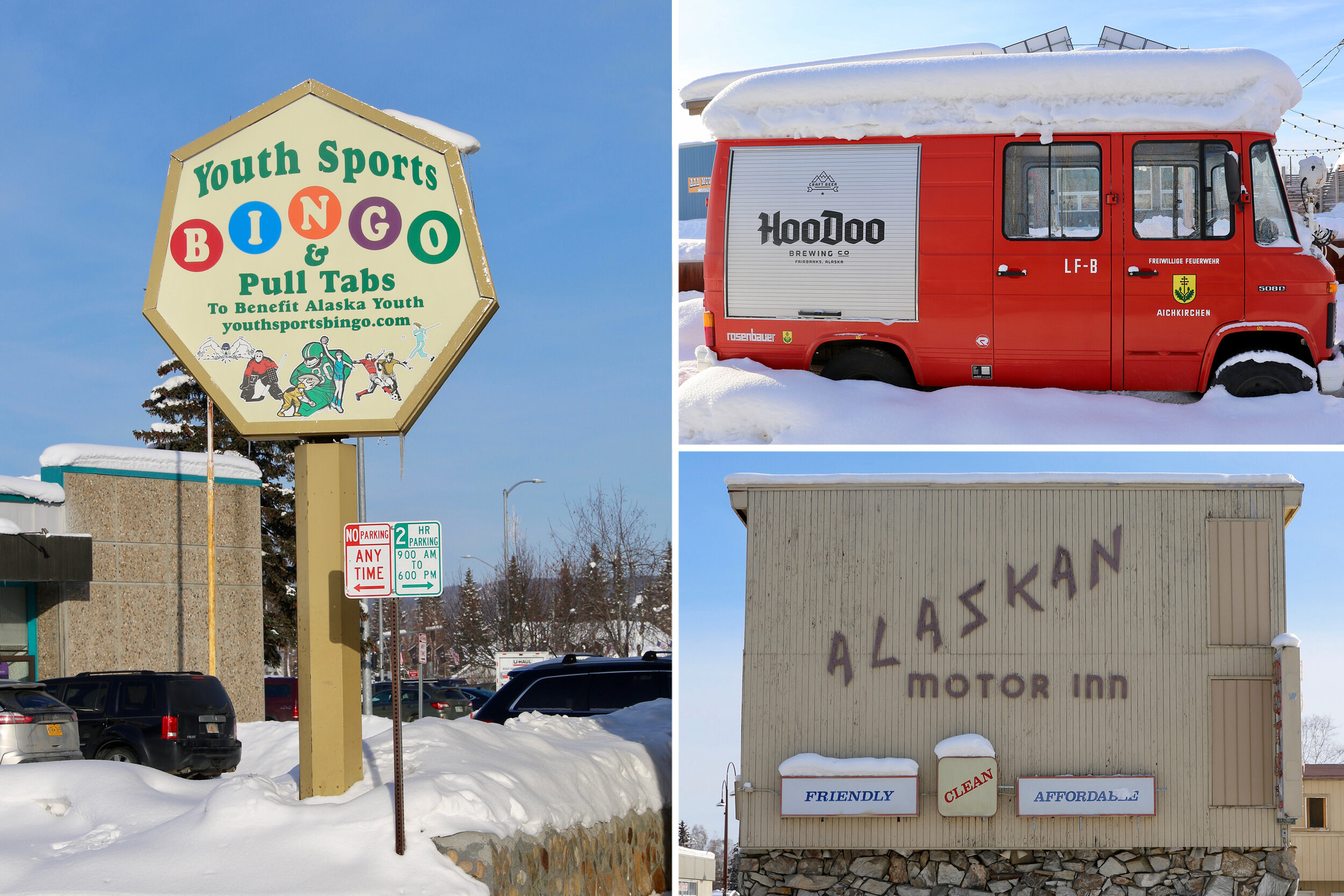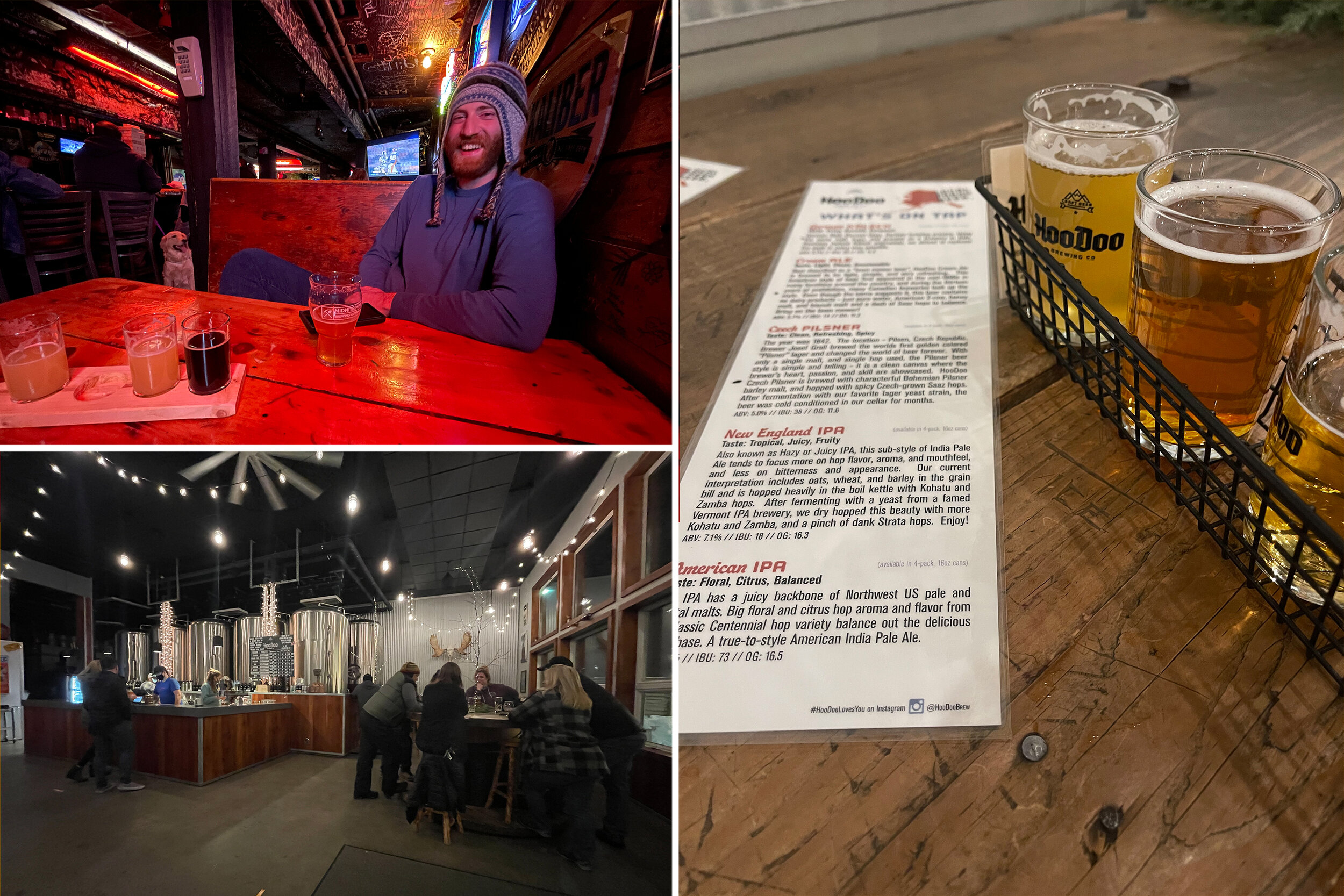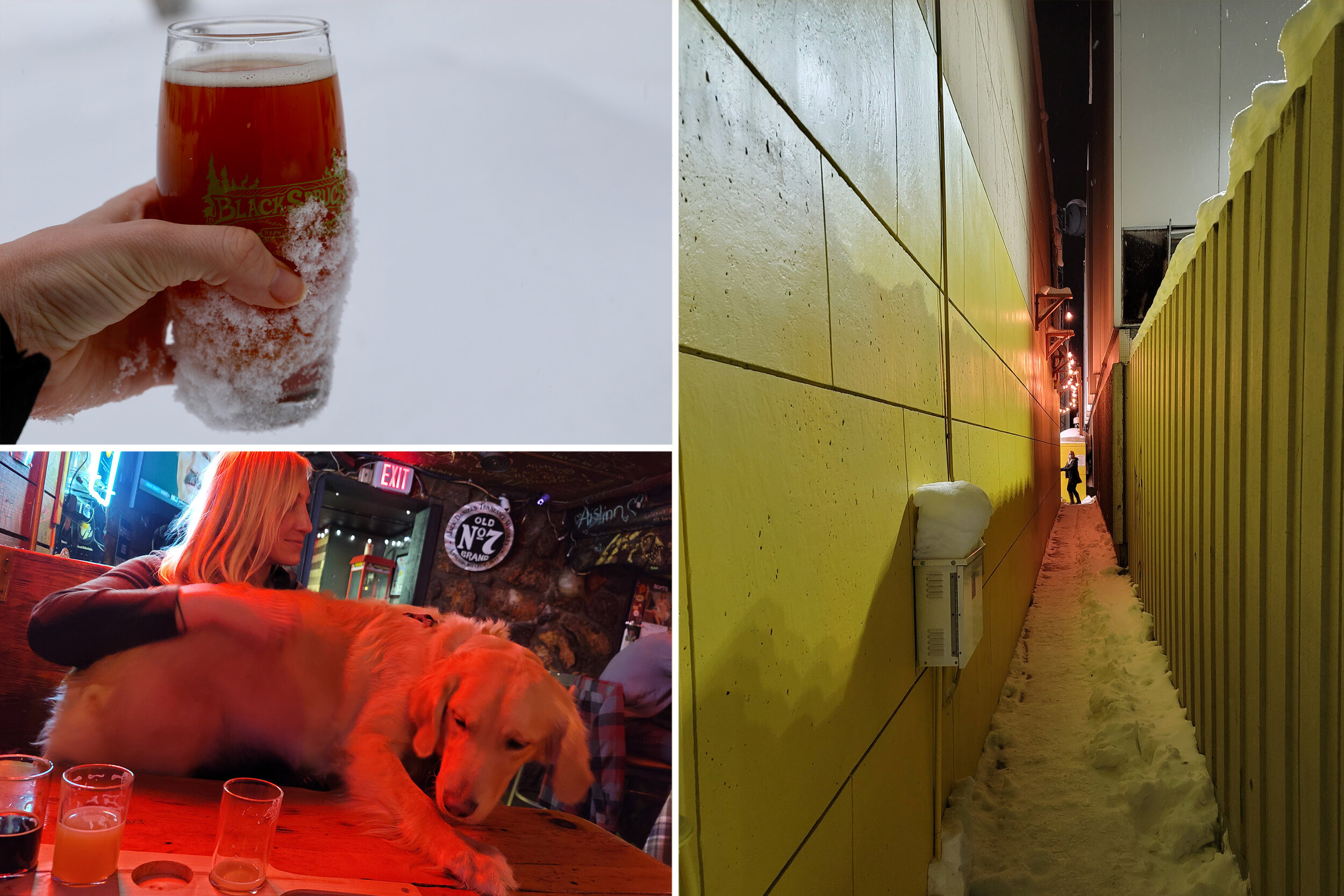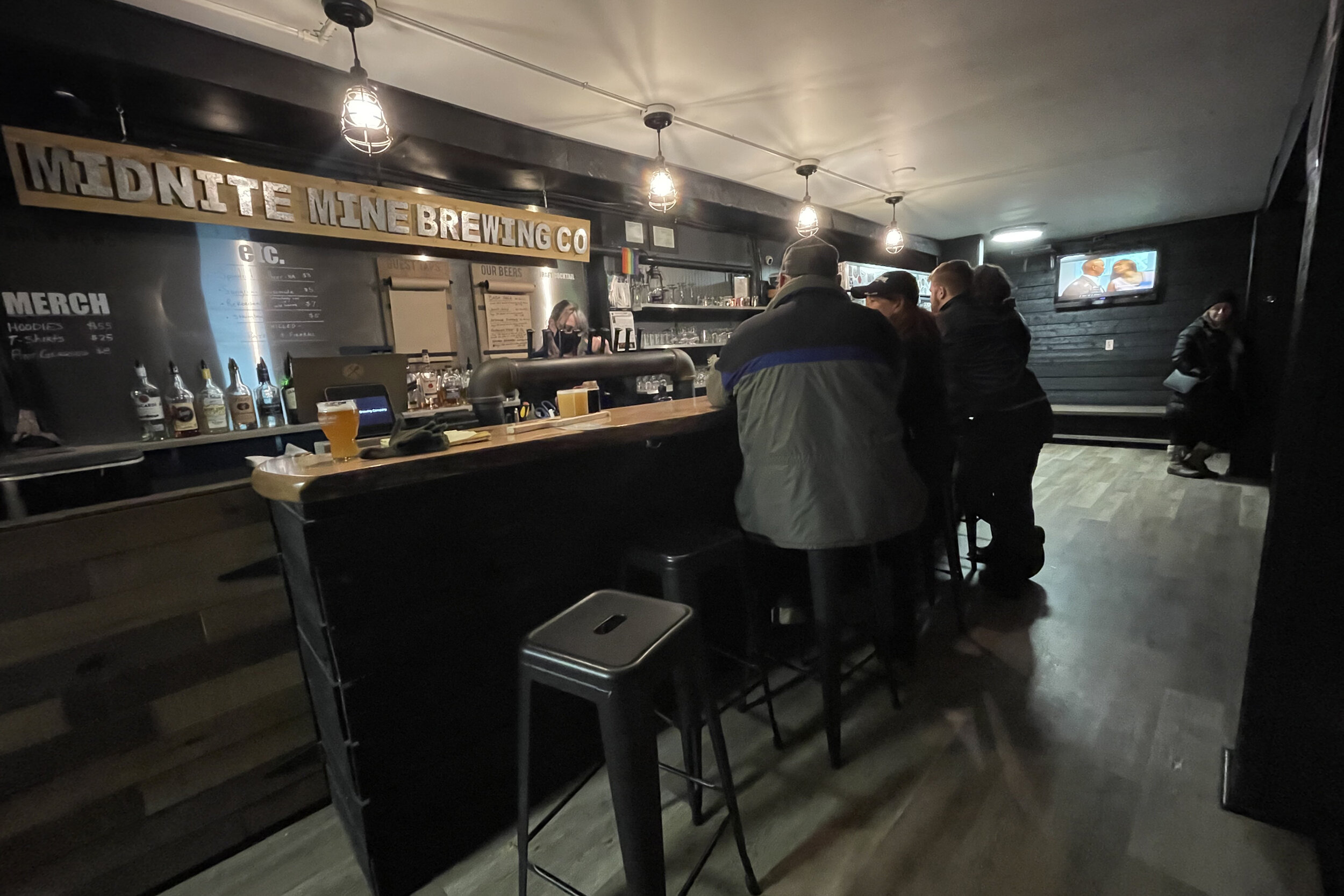It’s spring in Fairbanks, Alaska, at least in the sense that the locals are wearing shorts.
On this Friday night in March, the temperature is stuck at 10° Fahrenheit, and there’s enough snow on the perimeters of HooDoo Brewing Company’s beer garden that some kids have dug a series of tunnels in the mounds while their parents drink Imperial Stouts nearby.
But even with the snow and frosty air, at least two patrons are wearing sandals, several are without coats, and the bartender, John, casually rounds up glassware left outside in what can only be described as booty shorts.
“This is almost tropical,” John tells me when I question his outfit choice. He’s not necessarily wrong. The average low for Fairbanks is -15° Fahrenheit during the winter—here in Alaska’s interior, locals have a different understanding of cold. It’s a rite of passage to pose in swimwear next to a sign on the University of Alaska Fairbanks campus when its temperature display dips into particularly bitter lows (think 40 or 50 below).
But despite being a card-carrying Alaskan (based in Anchorage, a five-and-a-half-hour drive south of Fairbanks) for nearly six years, and wearing significantly more layers than my neighbors, I’m still cold.
“We just do things differently up here,” John says as he walks away.
With roughly 32,000 residents, Fairbanks is the only true city in interior Alaska. It was founded in 1901 when E.T. Barnette, a trading-post merchant, accidentally got stranded in the shallow Chena River while trying to sail supplies to the Tanacross gold fields. His could have been another story of a seeker-of-riches being outplayed by the wilds of Alaska, but instead he set up shop where he’d gotten stuck, and when a prospector struck gold a few miles away the following year, a boomtown sprung up around his store. By 1908, more than 18,000 people were living in the Fairbanks Mining District.
That plucky, make-do-with-what-you-have spirit has since come to characterize the city. In the century that followed, Fairbanks saw a handful of other booms. During World War II and the Cold War, it served as a strategic staging area for the military. After the discovery of the Prudhoe Bay oil field in 1968, Fairbanks acted as a construction hub for the Trans-Alaska Pipeline System (a fact that it is so proud of that most organized tours in the city schedule a stop somewhere guests can view it). More recently, the city has focused on tourism, arguing that with the midnight sun in the summer and the Northern Lights in the winter, it’s the year-round Alaska vacation spot.
Fairbanks is not your typical travel destination, though. The industries that have literally and figuratively built it have left their indelible mark on the city, and influenced its personality. There’s a gritty realness, and a local belief in practicality over presentation. Much of Fairbanks seems to consist of strip malls dispersed between two-story industrial buildings, most of which have corrugated tin siding to protect them from the elements. Where there aren’t structures, there are skinny spruce trees, some taller than the buildings.
“Fairbanks is a very strange and extreme place. If you’ve spent any time here, you may have noticed the people are a little different than other places. We worked to make the beers that they wanted to drink. ”
Residents believe saying “I’m from Fairbanks” carries a certain amount of cachet—like they’ve done battle with Jack Frost, the wilderness, and their own mental fortitude, and have come out all the stronger for it. Perhaps that’s why there’s that distinct regional pride—and why so many tap handles citywide are claimed by beers crafted within a few hundred miles. Where you might expect the homogeneity of macro Lagers, Fairbanks instead offers a wealth of locally made beers that span the style spectrum.
That wasn’t always true, though. When Silver Gulch Brewing & Bottling Co., the oldest brewery in Fairbanks (and the northernmost brewery in the U.S.), opened in 1998, it was the other way around.
“Twenty years ago there was nothing but Miller on tap and trying to get one of those handles was like pulling teeth,” says Silver Gulch owner Glenn Brady. The effort seems to have been worth it: Nearly everywhere we go, from coffee joints to pizza shops, is pouring Alaska-brewed beers.
How did Silver Gulch, and the other breweries that followed, manage to change the way this isolated town of oil field workers, miners, students, and military personnel drinks? We’re here to find out.
When the cold gets too intense, I follow John back inside HooDoo, and pick out a bright and citrusy New England IPA (which I hope will inspire warmth for myself) and a Czech Pilsner for my partner, Shaun. The two of us had planned to come up to Fairbanks for a long weekend months prior, but waited to make the drive until there was a good forecast for the Aurora Borealis—the city sits smack in the middle of where the auroral activity is highest. Though, if we’re being honest, seeing the Northern Lights was the secondary appeal of the trip. The first was the city’s increasingly well-known beer scene.
While Alaska has a fair number of breweries (45 at present, with more planned), it’s not always easy to get beers from faraway locales, except in the case of the most dominant players, like Denali Brewing Company north of Anchorage and Alaskan Brewing Company in Juneau. The state is vast, and many of the breweries, including those in Juneau or Kodiak, can only be reached by plane or boat—shipping their beer elsewhere is often prohibitively expensive. Over the years, we’ve made a sport of tracking down one-offs at bottle shops and taprooms, but those always felt like a tease. I needed to know what else was on offer at Fairbanks’ breweries and for that, I needed to go straight to the source.
Inside, HooDoo is much like the rest of Fairbanks: mostly metal, with touches of wood. It was founded by Bobby Wilken, a Fairbanks local who learned how to homebrew while in college. The beers on tap certainly don’t taste like homebrew, though—Wilken later went to brewing school in Chicago and Munich, and worked at Alaskan Brewing Company, before opening his taproom in 2011. When it opened, it was the second brewery in Fairbanks.
John slides the two beers across the bar—a pint for me and a 4oz taster for Shaun. He’d much rather have a full pour, but Alaska has some peculiar rules when it comes to enjoying beverages at breweries, largely due to an ongoing war with bars.
Because the cost of licensing a bar is significantly higher than a license for operating a brewery, many bar owners argue that if a brewery feels too much like a bar, it should be charged the same fees bars are. The situation, they say, can be likened to what taxi drivers experience after they’ve shelled out for expensive medallions for operation, only to have competition from a ride-sharing app that has a lower cost of entry. One of the compromises made was that no brewery tasting room could sell anyone more than 36oz of beer a day. For the sake of ease, most breweries choose to sell 12oz beers, though a handful of taprooms serve two 16oz pints with a 4oz taster. Other restrictions include a mandated 8 p.m. closing time, while state law prohibits live entertainment, dancing, televisions, pool tables, and all forms of games, rules which aren’t applied to bars.
None of those regulations have limited the popularity of breweries, though. By the time John toots the last-call train whistle (fitting, considering the Alaska Railroad passes by outside) both the taproom and the beer garden are packed.
After a long drive from Anchorage (and several more hours to kill until the Northern Lights are due to come out), the only logical thing to do is find somewhere for another round. After polling those sharing our fire pit, we land on Goldie’s.
“Your map is going to tell you to go through a narrow alley,” a man in a puffer jacket with multiple duct tape patches says. “Don’t worry, you’re in the right place.”
Calling the path from the parking lot to the front door an “alley” was being generous, it turns out—it’s just a bit wider than my shoulders—and from the outside, Goldie’s looks like an oversized storage unit. I worry for a second or two that we’ve been led astray.
Inside, however, I find exactly my kind of place. Parked diagonally across the turquoise room is a shiny, silver Airstream. From it, we order an IPA and a boozy lavender lemonade, both of which are served in glasses that depict a pink unicorn on one side and a lime-colored T. Rex on the other.
While we drink, we get to talking with the bartender. Despite being the second-largest city in the largest state in the Union, Fairbanks has a distinctly small-town feel. It’s possible to drive from one end to the other in under 15 minutes. While the city proper may be compact, the borough it’s in is sprawling. Just under 97,000 people call the Fairbanks North Star Borough, an area only slightly smaller than the state of New Jersey, home. Either way, it’s a place where everyone seemingly knows everyone else. At one point, I casually mention plans to meet up with the owner of a dozen reindeer who leads guided hikes. “Oh, Jane?” the bartender says. “You’ll have a great time, she’s a hoot.”
The reindeer hiker has hardly the most unique profession. While yes, the biggest local employers are the military, oil fields, gold mines, education, and government (both Tribal and otherwise), it wouldn’t be surprising if someone introduced themselves as a bush pilot, a sled dog racer, a trapper, an auroral photographer, or an ice sculptor.
After another round and a semi-drunken purchase of a pair of unicorn/dinosaur pint glasses (at the time, they seem like the ideal his-and-her pair), we decide to leave Goldie’s to retire to our hotel. We have a big brewery-hopping day planned for tomorrow.
On our way back, I’m halfway through uttering the words, “I wonder if we’ll see the Northern Lights tonight,” when we notice a faint, emerald glow in the distance. It’s impossible to pin down when the Aurora Borealis will make her entrance. Scientists measure geomagnetic activity and can estimate the general likelihood of seeing the swirling lights on a scale of zero to nine (known as the Kp Index). The higher the number, the greater the possibility. Granted, even if the probability is high and the sky is clear, there’s no guarantee—it’s really a matter of luck.
We stop and silently watch as the bands of green light pulse across the night sky. Just as it starts to feel like they’re reaching a crescendo, with the colors intensifying and the number of ribbons multiplying, they quickly peter out. Nature, it seems, had hit the dimmer switch.
The next morning, our first stop is Black Spruce Brewing Company, the middle child in Fairbanks’ brewing community.
Black Spruce opened on the winter solstice in 2018. On the shortest day of the year, there are just three hours and 41 minutes of daylight in Fairbanks.
Despite having been open for only a couple years, the brewery is known locally for its increasingly experimental, ambitious beers. Part of what’s informed their yen for creativity, according to co-owner Carey Fristoe, has been the support of the local community—with every seemingly unusual beer they introduce, they seem to get more and more devotees.
“Breweries generally do a good job of acting as community centers. When you have a lot of people gathering, it’s easier to introduce them to a new style of beer. It just grows from there. But people seem to be excited about trying something new.”
“It’s almost a kind of chicken-and-egg thing,” Fristoe says. “I think people always wanted these different styles of beer, but until recently didn’t have access to them.”
While we’re there, they have both a pistachio Imperial Stout and a tangerine mango Smoothie Sour on draft, among other beers that breweries with less to lose might shy away from.
“We have a fairly large network of brewing friends across the country that we bounce ideas off of, but yes, it’s a worry that if we do something that doesn’t work out, it’s a lot of money quite literally down the drain,” Fristoe says. Because Fairbanks is at the end of every distribution chain, it’s expensive to get everything from grains to glassware. Many ingredients need to be special-ordered.
There’s a common joke in Alaska that the state is always 10 years behind the trends of the Lower 48 (for instance, in July 2018, the last two Blockbusters closed in Alaska, a full 11 years after Netflix introduced streaming services and eight years after Blockbuster declared bankruptcy). Same, Fristoe says, goes for beer. Some styles that were fads several years ago are just being introduced in Alaska now. For his team, it means a lot of education for their local clientele.
“Breweries generally do a good job of acting as community centers,” Fristoe says. “When you have a lot of people gathering, it’s easier to introduce them to a new style of beer. It just grows from there. But people seem to be excited about trying something new.”
When you meet someone new in Alaska, the first question after “What’s your name?” is usually, “Where’d you come from?” The fact is, most Alaskans are newcomers. Only about a third of the population was born and raised within the state, while the rest are from Outside. It’s also an incredibly transient state. Each year, 50,000 people move to Alaska, and roughly the same number leaves. It’s a place that requires a certain kind of personality to stay long-term, so the turnover rate is high. Arguably, what motivates people to relocate to the 49th state is a mix of an independent streak, an appreciation for nature, and a craving for new experiences.
It makes sense that a demographic in flux would inspire local businesses to play with, or at least dip their toe into, novelty.
Midnite Mine Brewing Company, the next stop on our brewery crawl, arguably best bridges the gap between old-school, unchanged-since-pre-statehood Fairbanks dives and newer breweries focusing on innovation—because it’s both.
Up until 2018, it was strictly a dive bar, the kind of place where beards and flannel abounded, with a flickering Miller High Life sign above pool tables with scratched felt, walls covered in chalk, a pin-up poster on the beer fridge, and a policy that allowed dogs to sit at the bar. It still has all that, but now there’s also a nano-brewery upstairs. (The dog we meet during our visit is named Taiga, and she is the best buddy.)
“I like the idea of people coming into the bar for a Miller Lite and wandering upstairs to see what’s going on. We’re able to say, ‘Oh you like that, here, try this Blonde or this Kölsch.’ When we’re able to introduce them to something new that they like, they’ll trust us more to try something crazier, like a Sour brewed with blueberry muffins.”
“I like the idea of people coming into the bar for a Miller Lite and wandering upstairs to see what’s going on,” says brewer Talon Hobbs. “We’re able to say, ‘Oh you like that, here, try this Blonde or this Kölsch.’ When we’re able to introduce them to something new that they like, they’ll trust us more to try something crazier, like a Sour brewed with blueberry muffins.”
Hobbs says he gets even more support for off-the-wall beers when he sources ingredients locally, like using spruce from a customer or buying raspberries from local kids.
“I always call it a ‘farmer’s market culture,’” Hobbs says. “Like, when there’s a farmer’s market going on, the grocery store is dead. People want to be involved with the producers and cultivators and in that sense, be involved in the process.”
Even though bars and breweries have butted heads in the past in terms of licensing, many of the former religiously carry the latter’s products. Hobbs points to Lavelle’s Taphouse, Venue Coffee House, and Goldie’s as bars and cafes that are local supporters. Later in the day, we question the owner of East Ramp Pizza (a restaurant that sits on the edge of the city’s airstrip), Wendy Ehnert, about why they don’t carry any out-of-state beers. While guests have certainly asked for macro Lagers, Ehnert says, she’d rather use their limited amount of space to support local. She’s not even sure how much of a price difference it would be to get a keg of something like Budweiser or Sam Adams Boston Lager—she never looked into it.
“It’s not charity—they’re phenomenal beers,” Ehnert says. “I’m not putting out my brother’s basement brew or something like that. I wouldn’t sell these breweries’ beers if they weren’t great beers.”
Ehnert argues that a large part of the appeal of travel is trying new things, so local craft beer should fall under that umbrella. “People who come to Fairbanks want to see the Northern Lights, they want to go for a ride on a dogsled, and more often than not, they want to have a good local beer,” Ehnert says.
Each of the breweries I speak to in Fairbanks (including the people behind Lat. 65 Brewing Co., which hopes to open later this spring), credits Silver Gulch for paving the way and starting a collective shift in what locals want to drink. They made it work, Brady says, by understanding the locals and making beers that speak to them.
Silver Gulch’s original location (it also has a bar in the Ted Stevens Anchorage International Airport), is technically in Fox (population: 400), about 20 minutes north of downtown Fairbanks. Due to the pandemic, the cavernous brewery and restaurant is only open for to-go orders while we’re in town, but we swing through for a pair of pizzas before embarking on the long drive back to Anchorage (and grab some beers to enjoy as a reward once we make it home).
Interestingly, Silver Gulch’s tap list is the least off-the-wall—it primarily brews simple, true-to-style beers like Vienna Lagers, Pilsners, and Porters. Brady explains that his team typically sticks to beers that “people want to drink more than one of.”
“Fairbanks is a very strange and extreme place,” Brady says. “If you’ve spent any time here, you may have noticed the people are a little different than other places. We worked to make the beers that they wanted to drink.”
Getting its beers into the hands of locals, and sparking their interest in trying something new, were the first baby steps Silver Gulch made that allowed other breweries to follow in its wake. In doing so, the brewery triumphed in its bigger goal, of showing its neighbors what good craft beer could be.
That ethos is what inspired its tagline: “Fairbanks, where the people are unusual and the beer is unusually good.”
“The slogan still holds all these years later,” Brady says. “We just have more company now.”































